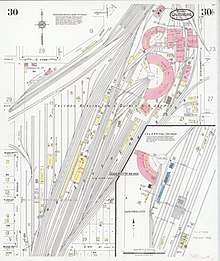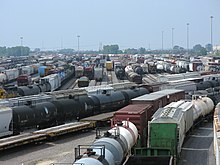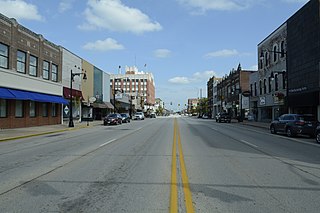
Galesburg is a city in Knox County, Illinois, United States. The city is 45 miles (72 km) northwest of Peoria. At the 2010 census, its population was 32,195. It is the county seat of Knox County and the principal city of the Galesburg Micropolitan Statistical Area, which includes all of Knox and Warren counties.

BNSF Railway is the largest freight railroad in the United States. One of six North American Class I railroads, BNSF has 36,000 employees, 33,400 miles (53,800 km) of track in 28 states, and over 8,000 locomotives. It has three transcontinental routes that provide rail connections between the western and eastern United States. BNSF trains traveled over 169 million miles in 2010, more than any other North American railroad.

The Burlington Northern Railroad was a United States-based railroad company formed from a merger of four major U.S. railroads. Burlington Northern operated between 1970 and 1995.

The Chicago, Burlington and Quincy Railroad was a railroad that operated in the Midwestern United States. Commonly referred to as the Burlington Route, the Burlington, or as the Q, it operated extensive trackage in the states of Colorado, Illinois, Iowa, Missouri, Nebraska, Wisconsin, Wyoming, and also in Texas through subsidiaries Colorado and Southern Railway, Fort Worth and Denver Railway, and Burlington-Rock Island Railroad. Its primary connections included Chicago, Minneapolis–Saint Paul, St. Louis, Kansas City, and Denver. Because of this extensive trackage in the midwest and mountain states, the railroad used the advertising slogans "Everywhere West", "Way of the Zephyrs", and "The Way West".

A rail yard, railway yard, railroad yard (US) or simply yard, is a series of tracks in a rail network for storing, sorting, or loading and unloading rail vehicles and locomotives. Yards have many tracks in parallel for keeping rolling stock or unused locomotives stored off the main line, so that they do not obstruct the flow of traffic. Cars or wagons are moved around by specially designed yard switcher locomotives (US) or shunter locomotives (UK), a type of locomotive. Cars or wagons in a yard may be sorted by numerous categories, including railway company, loaded or unloaded, destination, car type, or whether they need repairs. Yards are normally built where there is a need to store rail vehicles while they are not being loaded or unloaded, or are waiting to be assembled into trains. Large yards may have a tower to control operations.

The BNSF Line is a Metra commuter rail line operated by the BNSF Railway in Chicago and its western suburbs, running from Chicago Union Station to Aurora, Illinois. In 2010, the BNSF Line continued to have the highest weekday ridership of the 11 Metra lines. While Metra does not refer to its lines by particular colors, the BNSF line's color on Metra timetables is "Cascade Green," in honor of the Burlington Northern Railroad.
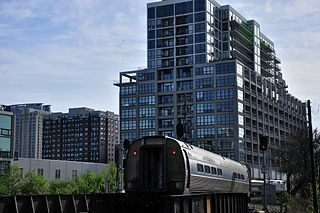
The St. Charles Air Line is a rail line in Chicago, Illinois, partially owned by the BNSF Railway, Union Pacific Railroad (UP), and Canadian National Railway (CN).

Galesburg is an Amtrak intercity train station in Galesburg, Illinois, United States. The station was originally built in 1984, after the razing of the large depot just south of the current site. It is located north of the large BNSF Classification yard. Just south the Illinois Zephyr and Carl Sandburg diverge via the Quincy main line which bypasses the yard on the east side. The California Zephyr and the Southwest Chief continue to the southwest side of Galesburg near Knox College.

Crossing the Kansas River in Kansas City, Kansas, the Highline Bridge is rare example of a double-tracked, double-deck railroad bridge designed for carrying railroad traffic on both levels. The bridge is owned and operated by the Kansas City Terminal Railway (KCTR) and provides access between the extensive rail yards on both sides of the river in the Argentine and Armourdale neighborhoods in Kansas City, Kansas and other rail yards in Kansas City, Missouri.
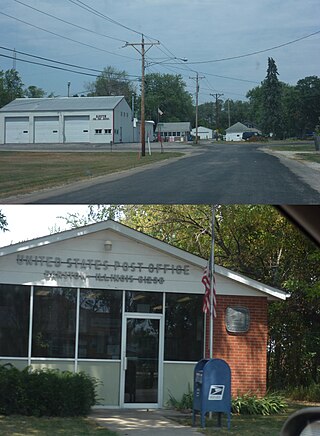
Barstow is an unincorporated community in Rock Island County, Illinois, United States. Barstow is east of East Moline and Silvis. Barstow is located on a wye that connects track owned by the BNSF Railway, including the Barstow Subdivision. These tracks were previously owned by the Chicago, Burlington and Quincy Railroad (CB&Q), and a station once existed within the wye.

The Chicago and Aurora Railroad was an early predecessor of the Chicago, Burlington and Quincy Railroad that built a line from West Chicago to Mendota via Aurora, Illinois.

The Chicago Subdivision or Chicago Sub is a railroad line in Illinois that runs about 38 miles (61 km) from Chicago to Aurora and hosts Metra's BNSF Railway Line commuter service. It is operated by BNSF Railway as the easternmost part of the railroad's Northern Transcon to Seattle, Washington. This line is known as the Racetrack because it is mostly triple-tracked and supports fairly fast trains. It had been operated by a BNSF ancestor, the Chicago, Burlington and Quincy Railroad, which introduced high-speed Zephyr passenger trains in 1934 and ran many of them along this subdivision from Chicago to points west.

Streator Station was a train station located in Streator, Illinois, United States. It was served by numerous Atchison, Topeka and Santa Fe Railway (AT&SF) passenger trains during its heyday. Amtrak served the station until 1996 with the Southwest Chief between Chicago and Los Angeles daily. When the Burlington Northern Railroad and the AT&SF railways merged, BNSF built a connecting track between the two main lines east of Cameron, Illinois,. This allowed passenger trains to change from the former Chicago, Burlington and Quincy Railroad (CB&Q) main line to the Southern Transcon freely. This along with the amendment of a stretch of track that was essential for getting to Chicago Union Station forced Amtrak to reroute the Southwest Chief to bypass Chillicothe and Streator.

Galesburg Santa Fe Station was a railway station in the west central Illinois town of Galesburg. The station was along the Atchison, Topeka and Santa Fe Railway's main line and served trains such as the Super Chief and El Captain. After Amtrak took over intercity rail in the United States, it was served by trains such as the Lone Star (1971–1979) and the Southwest Chief (1971–1996).
The Cameron connector is a section of track built in 1995–1996 which connects the former Burlington Northern Railroad and the former Atchison, Topeka and Santa Fe Railway tracks, both which are now part of the BNSF Railway, to each other near Cameron, Illinois.
Walter Theodore Krausch, known as W.T. Krausch (1868–1929), was an American architect, engineer, and inventor who worked for the Chicago, Burlington and Quincy Railroad (CB&Q) from the late 1880s to the 1920s.
The Chillicothe Subdivision or "Chillicothe Sub" is a railway line running about 229 miles (369 km) from Chicago, Illinois to Fort Madison, Iowa in the United States of America. It is operated by BNSF Railway as part of their Southern Transcon route from Chicago to Los Angeles. The Chillicothe Subdivision is a high volume route connecting three principal yards in Chicago in the east and the Marceline Subdivision in the west which continues to Kansas City.
Barstow Yard is a classification yard operated by Burlington Northern Santa Fe Railway (BNSF) in Barstow, California. With 48 directional tracks and a total area of approximately 600 acres (240 ha), it is the second largest classification yard west of the Rocky Mountains after the JR Davis Yard. Today, almost all freight traffic to and from Southern California runs through the junction.

Chicago, Burlington and Quincy 5632 was an O-5b class 4-8-4 “Northern” built in the CB&Q's shops in August 1940. It was used to pull mainline passenger and freight trains before it eventually became famous for pulling a plethora of excursion trains for the CB&Q's steam excursion program. By the time the program ended in 1966, No. 5632 was disassembled for an unfinished overhaul, and was subsequently sold to locomotive caretaker Richard Jensen. The locomotive was stored inside a roundhouse waiting for restoration until 1969, when it was illegally moved to a scrapyard. The locomotive derailed on a switch in 1972, resulting in its scrapping and a subsequent lawsuit between the scrapyard and Jensen.
Chicago, Burlington and Quincy 4963 is a preserved class "O-1a" 2-8-2 "Mikado" type steam locomotive originally built by the Baldwin Locomotive Works in 1923 for the Chicago, Burlington and Quincy Railroad. It was used by the CB&Q to haul mainline freight trains before it was leased to the Bevier and Southern Railroad to haul short-distance freight trains in the early 1960s. It was subsequently retained by the CB&Q and used as a source of spare parts before being acquired by Richard Jensen.







